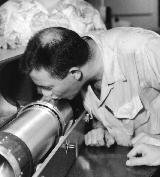|
(Files in red–history) |
Stoermer's CalculationsAn isolated magnetic pole is a mathematical abstraction and has not been observed (though a few people keep trying). Later Birkeland built bigger vacuum chambers and replaced the magnet with a magnetized sphere or "terrella" representing the Earth, noting that the electrons were channeled towards both its poles. A more practical problem, therefore, was particle motion near a compact bar magnet or "dipole", which better modeled the field of the Earth or of his terrella. Birkeland therefore suggested that problem to a friend, the mathematician Carl Stoermer, who devoted to it an appreciable part of his career. Stoemer never found a full solution, a formula which would predict the particle's motion to all time, like the formula for the motion of a single planet around an isolated sun. In fact, none exists in conventional mathematical terms, because the motion is inherently intricate (in today's terms, a "chaotic motion," an area pioneered by Poincaré). But he did show that large families of orbits would remain trapped forever.The orbits Stoermer was most concerned with belonged to particles with rather high energies. In general they did not resemble tidy spirals, because they covered large sections of the magnetic field, and in the course of each excursion around the field, the intensity and direction of the magnetic field did not stay the same but varied appreciably. Later, when cosmic rays were discovered, it turned out that Stoermer's theory applied quite well to their motion: but it did not solve the mystery of the polar aurora, as Stoermer had hoped.
|
